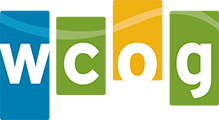The following programs are administered by WCOG to advance regional transportation goals as well as support state and national objectives.
Transportation demand management: Whatcom Smart Trips
Transportation demand management (TDM) reduces the demand for overburdened roads by providing opportunities for people to use sustainable modes like walking, biking, sharing rides and riding the bus, or to not travel at all (such as working from home). In the Whatcom region, TDM is primarily implemented under the auspices of WCOG’s Whatcom Smart Trips program. The program is currently funded through a partnership among WTA, WSDOT, the City of Bellingham and the Northwest Clean Air Agency.
Whatcom Smart Trips is a collection of initiatives and tools that help and encourage community members to use more efficient and sustainable transportation modes. These include:
- An online trip diary that helps community members identify opportunities for making trips by walking, bicycling, sharing rides and riding the bus
- Smart Trips Incentives, which include discount cards, gift certificates, cash prizes and recognition to motivate community members to try new forms of transportation
- Emergency rides home using limited, free taxi service so bus riders and other Smart Trips participants who experience an emergency or become ill at work can get home
- Smart Trips employer partners to provide support to businesses and organizations that want to promote sustainable transportation to their employees
- Community outreach provides education, assistance and incentives by partnering with community groups that wish to promote walking, bicycling, sharing rides and riding the bus
- School Smart Trips program, which provides classroom activities for middle school students and bicycle skills courses for elementary school students
- An ongoing public awareness campaign that includes advertising and public presentations to make the community aware of the benefits of participation in the Smart Trips program.
In addition to Whatcom Smart Trips, several jurisdictions in the Whatcom region utilize TDM as part of their local transportation strategies. Taken together, regional TDM programs advance the Whatcom regional goals of:
- Efficiency, effectiveness and system sustainability – Reducing single-occupant vehicle travel contributes to reduced traffic congestion, faster travel time, and reduced road maintenance needs. It also supports WTA through increased ridership.
- Environmental quality – Increased walking and biking advances healthy communities both as a function of increased physical activity and avoided vehicle-related emissions.
- Multimodal transportation system – Increasing people’s awareness of the transportation options they have and informing them how to use more modes directly increases the viability and value of transit, ride-share services, bicycle and pedestrian facilities and indirectly improves effectiveness of roads.
Coordination of cross-border planning, programming and operations: The International Mobility and Trade Corridor Program (IMTC)
The Whatcom region’s northern boundary is the United States’ international border with Canada. While the Whatcom region is home to about 212,000 people, just across that border there are approximately 2.5-million people living in Metro Vancouver, one of Canada’s largest metropolitan areas. As an international border region, the Whatcom transportation system includes the national facilities of U.S. and Canadian federal border inspection agencies. Whatcom County’s location on the coastal transportation corridor between Vancouver, B.C. and Seattle results in high volumes of nationally-significant truck and rail freight through the region. Additionally, this asymmetrical population density is a very important dimension of transportation demand in the Whatcom region: in 2015, approximately 4.2-million Canadian vehicles crossed the border into the Whatcom region, with approximately 46 percent of those trips (1.9-million vehicles/4.4-million person trips) having destinations in Whatcom County (per the 2013 IMTC travel survey). This level of activity has a significant positive impact on the Whatcom region’s economy, but also generates a large share of the vehicles using the regional road system. These added cross-border flows of freight and travel are important factors in WCOG’s metropolitan and regional transportation planning process.
Since 1997, WCOG has been the lead agency of the IMTC, a voluntary, binational coalition of government, business interests and non-governmental entities established to support the improvement of safety, mobility and security in the “Cascade Gateway” – the five land-border ports-of-entry connecting Whatcom County to B.C.’s Lower Mainland. The IMTC program focuses on coordinating planning, identifying shared system needs, and optimizing investments and operations through collaboration, innovation and partnership. Active participants include:
- U.S. Federal Highway Administration
- Transport Canada
- U.S. Customs and Border Protection
- Canada Border Services Agency
- WSDOT
- B.C. Ministry of Transportation & Infrastructure
- B.C. and Washington border municipalities
- U.S. Consulate, Vancouver
- Canadian Consulate, Seattle
- Industry associations (trucking, customs brokers, duty-free stores)
- Federal, state, provincial and local legislative offices
- Non-governmental organizations
Because it encompasses planning, programming and operations, IMTC advances all of the Whatcom region’s transportation goals to some degree. However, because it addresses the functionality and performance of the region’s five ports-of-entry as part of the Cascade Gateway system, IMTC has the most directly advances the regional goals of:
- Efficiency, effectiveness and system sustainability
- A multimodal transportation system
- Access and convenience, and
- Freight transportation.
More information on the objectives and strategies of the IMTC Program can be found in IMTC Purpose, Goals and Strategies.
